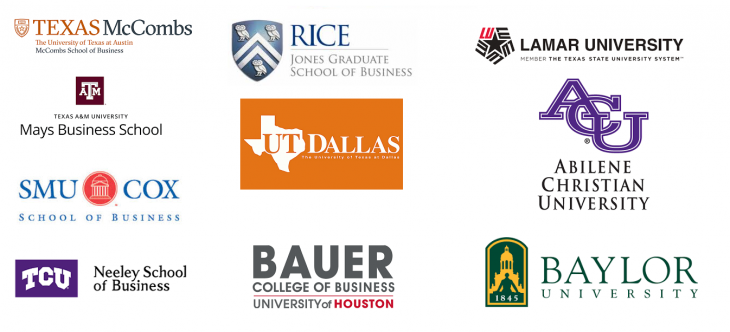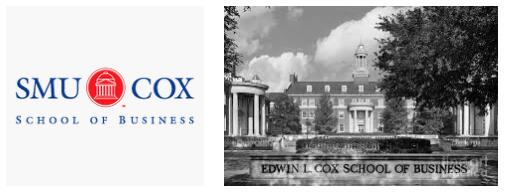Search top business school MBA programs in the state of Texas. Find latest rankings of MBA schools national wide and state wide. For detailed admissions statistics and graduate employment rate, check the following table for each top-ranked business college within Texas, with acceptance rate, average GPA and GMAT scores, as well as well tuition and starting salary information of all best MBA universities in Texas.
Texas is home to some of the top business schools in the nation, offering excellent educational opportunities for those pursuing a career in business. The state is home to several prestigious universities such as the University of Texas at Austin and Texas A&M University, both of which offer MBA and specialized master’s degree programs.
At the University of Texas at Austin (UT Austin), students can pursue an AACSB-accredited MBA degree with concentrations such as Finance, Strategic Management or Entrepreneurship. UT Austin also offers specialized master’s degrees like MS in Business Analytics & Decision Making Science or MS in Cybersecurity & Information Assurance Management. Students can further enhance their business education through UT Austin’s Executive Education Programs which provide customized courses designed specifically for their needs and goals.
Texas A&M University is another great option for those seeking a business education in Texas. This university offers an AACSB-accredited MBA program with concentrations such as International Business or Supply Chain Management, as well as specialized master’s degrees like MS in Accounting or MS in Real Estate Development & Investment. In addition to its traditional courses, Texas A&M also provides unique learning experiences through its Executive Education Programs which allow professionals from all industries to develop their skillset further through customized courses designed specifically for their needs and goals.
The McCombs School of Business at The University of Texas at Austin also offers an excellent range of business programs, including undergraduate majors such as Accounting, Economics or Marketing as well as specialized master’s degrees like MS in Human Resource Management or MS in Digital Innovation & Technology Management. The school also provides several certificate programs to help students enhance their professional development even further and stay up-to-date with the latest industry trends.
Aside from traditional universities, there are also many other options for those seeking a business education in Texas. For example, many community colleges throughout the state offer Associate’s degrees in Business Administration that can provide students with a solid foundation for entry-level positions within the field. Additionally, there are several other private institutions offering undergraduate and graduate level business degrees that may be worth considering depending on your educational goals and budget constraints.
Overall, there are plenty of options available for those looking to pursue a career in business within the state of Texas. Whether you choose to attend one of the prestigious universities mentioned above or opt for an alternative route such as a community college or private institution – you will find plenty of excellent educational opportunities available throughout the state that can help you achieve your desired career outcomes!

| National Ranking | Best Business MBA Programs |
| 17 | University of Texas–Austin (McCombs) (Austin, TX) Acceptance rate: 25.3% Average GMAT score: 692 Average undergraduate GPA: 3.43 Tuition: In-state, full-time: $32,140 per year; Out-of-state, full-time: $47,136 per year Enrollment (full-time): 534 Average starting salary and bonus: $118,410 Full-time graduates employed at graduation: 75.2%  |
| 26 | Rice University (Jones) (Houston, TX) Acceptance rate: 25.2% Average GMAT score: 673 Average undergraduate GPA: 3.40 Tuition: Full-time: $44,000 per year Enrollment (full-time): 222 Average starting salary and bonus: $108,175 Full-time graduates employed at graduation: 73.2%  |
| 33 | Texas A&M University–College Station (Mays) (College Station, TX) Acceptance rate: 27.4% Average GMAT score: 647 Average undergraduate GPA: 3.50 Tuition: In-state, full-time: $8,156 per year; Out-of-state, full-time: $19,424 per year Enrollment (full-time): 136 Average starting salary and bonus: $97,279 Full-time graduates employed at graduation: 66.7%  |
| 41 | University of Texas–Dallas (Richardson, TX) Acceptance rate: 25.8% Average GMAT score: 662 Average undergraduate GPA: 3.54 Tuition: In-state, full-time: $12,935 per year; Out-of-state, full-time: $25,357 per year Enrollment (full-time): 111 Average starting salary and bonus: $76,272 Full-time graduates employed at graduation: 58.8%  |
| 53 | Southern Methodist University (Cox) (Dallas, TX) Acceptance rate: 37.0% Average GMAT score: 641 Average undergraduate GPA: 3.25 Tuition: Full-time: $41,368 per year Enrollment (full-time): 246 Average starting salary and bonus: $88,693 Full-time graduates employed at graduation: 61.1%  |
| 63 | Baylor University (Hankamer) (Waco, TX) Acceptance rate: 35.8% Average GMAT score: 624 Average undergraduate GPA: 3.36 Tuition: Full-time: $28,720 per year Enrollment (full-time): 87 Average starting salary and bonus: $67,617 Full-time graduates employed at graduation: 73.2%  |
| 72 | Texas Christian University (Neeley) (Fort Worth, TX) Acceptance rate: 70.3% Average GMAT score: 643 Average undergraduate GPA: 3.19 Tuition: Full-time: $33,750 per year Enrollment (full-time): 97 Average starting salary and bonus: $75,915 Full-time graduates employed at graduation: 63.0%  |
| 91 | University of Houston (Bauer) (Houston, TX) Acceptance rate: 74.3% Average GMAT score: 582 Average undergraduate GPA: 3.25 Tuition: In-state, full-time: $10,846 per year; Out-of-state, full-time: $18,358 per year Enrollment (full-time): 167 Average starting salary and bonus: $59,353 Full-time graduates employed at graduation: 60.6%  |
| 102 | Abilene Christian University (Abilene, TX) Acceptance rate: 60.7% Average GMAT score: N/A Average undergraduate GPA: 3.41 Tuition: Full-time: $23,610 per year Enrollment (full-time): 26 Average starting salary and bonus: N/A Full-time graduates employed at graduation: N/A  |
| 111 | Lamar University (Beaumont, TX) Acceptance rate: N/A Average GMAT score: 482 Average undergraduate GPA: N/A Tuition: In-state, full-time: $8,354 per year; Out-of-state, full-time: $15,868 per year Enrollment (full-time): 85 Average starting salary and bonus: $70,100 Full-time graduates employed at graduation: 51.6%  |
Texas is a state located in the South Central region of the United States. It is bordered by Oklahoma to the north, Arkansas to the northeast, Louisiana to the east, New Mexico to the west and Mexico to the south. Texas has a humid subtropical climate with hot summers and mild winters. The capital city of Texas is Austin which is located in Travis County. Texas has a population of over 28 million people and is known for its diverse culture, vibrant economy and its vast size.
The state of Texas offers plenty of attractions such as Big Bend National Park, San Antonio Riverwalk, and many other parks throughout the state. In addition to its natural beauty, there are also plenty of cultural activities available throughout Texas such as museums, galleries and performing arts venues located throughout major cities like Houston, San Antonio and Dallas-Fort Worth. There are also plenty of recreational opportunities available throughout Texas including fishing, hunting, hiking, camping and more at Lake Texoma or Palo Duro Canyon State Park as well as numerous other parks throughout the state.
Texas Population
About 25,600,000 people live in the state of Texas (the second largest population among US states. The average population density in Texas is about 38 people per km 2 (twenty-sixth place in the USA).
There are three cities in Texas with a population of more than a million people: Houston, ranked fourth in the list of the largest US cities (about 2,100,000 residents), San Antonio (1,330,000 residents, seventh place) and Dallas (1,225,000 residents, ninth place). Three other cities have more than half a million residents: the state capital Austin (820,000, thirteenth), Fort Worth (760,000, sixteenth), and El Paso (660,000, nineteenth).
The largest urban agglomerations in the “Lone Star State” formed around Dallas and Fort Worth (more than 6,500,000 people, fourth place in the list of US metropolitan areas), Houston (about 6,100,000 people, fifth place), San Antonio (2,200 000 residents, twenty-fourth place) and Austin (about 1,800,000 residents, thirty-fourth place).
Located relatively close to each other, the five largest cities in Texas (Houston, San Antonio, Dallas, Fort Worth and Austin) are often called the “Texas Triangle”, about three-quarters of the population of Texas live in this largest metropolitan area.
The racial makeup of Texas is:
- White – 70.4%
- Black – 11.8%
- Asians – 3.8%
- Native Americans (Indians or Eskimos of Alaska) – 0.7%
- Native Hawaiian or Oceanian – 0.1%
- Other races – 10.5%
- Two or more races – 2.7%
- Hispanic or Latino (of any race) – 37.6%
Although whites make up about 70% of Texas’s population, non-Hispanic whites (that is, Europeans) in the Lone Star State are only about 48%. Texas is one of four U.S. states (along with the states of Hawaii, California, and New Mexico) in which European descendants are a minority.
The largest ethnic (national) groups among the population of the state of Texas:
- Mexicans – 31%
- English – 27%
- Descendants of immigrants from Africa (African Americans) – about 12%
- Germans – 11%
- Irish – 8%
- French – 2.5%
- Italians – 2%
A significant (estimated at about 6%) of the state’s population are illegal immigrants, mostly from neighboring Mexico. Texas ranks fifth in the United States in terms of the number of illegal immigrants to the total population (after Nevada, Arizona, California and New Jersey).
The largest Texas populations by religion are:
- Christians – more than 80%, including:
- Protestants – more than 50%, including:
- Baptists – about 21%
- Methodists – about 8%
- Lutherans – about 3%
- Pentecostals – about 3%
- Presbyterians – about 2%
- Catholics – about 28%
- The Church of Jesus Christ of Latter-day Saints (Mormons) – about 2%
- Jehovah’s Witnesses – about 1%
- Orthodox – less than 1%
- Protestants – more than 50%, including:
- Muslims – about 1%
- Jews – less than 1%
- Atheists – about 11%
Texas (especially the eastern counties of the state) is traditionally included in the ” Bible Belt “, a region in which there is a very large number of believers among the population, and the predominant religion is evangelical Protestantism (in particular Baptism). There are several Protestant “megachurches” in Texas, where services are attended by thousands of parishioners. The most famous of them are Potters House in Dallas and Lakewood in Houston.
